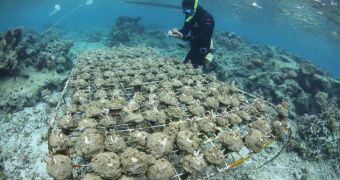For the first time ever, a group of investigators managed to produce conclusive scientific evidence that certain species of seaweeds are capable of killing corals just by touching them. Scientists from the Georgia Institute of Technology (Georgia Tech) made the discovery in a series of experiments that they ran on the green seaweed Chlorodesmis, an aquatic organism featuring filamentous fronds. They determined that the weed was capable of using a potent cocktail of chemicals to kill corals by simply touching them. The new data will be used to better inform reef conservation efforts.
“Between 40 and 70 percent of the seaweeds we studied killed corals. We don't know how significant this is compared to other problems affecting coral, but we know this is a growing problem. For reefs that have been battered by human use or overfishing, the presence of seaweeds may prevent natural recovery from happening at all,” explains Georgia Tech marine ecologist Mark Hay, who was a member of the research team. According to the expert, the same trend was found to be true both in the Pacific Ocean and in the Caribbean Sea. Details of the investigation were published this week in the early online issue of the esteemed journal Proceedings of the National Academy of Sciences (PNAS).
The new work was conducted using funds provided by the US National Science Foundation (NSF), the National Institutes of Health (NIH), and the Teasely Endowments at Georgia Tech. According to the director of the NSF Biological Oceanography Program, David Garrison, the development of seaweed population is generally kept in check by herbivorous fish living around coral reefs. However, due to human pollution and overfishing, these populations have been heavily depleted, which in turn opened new grounds for seaweeds such as Chlorodesmis to expand on. This is a very worrying discovery, given that coral reefs are declining in size, spread and health worldwide.
“Removing the herbivorous fishes really sets up a cascade of effects. If there are fewer fish, the seaweeds outgrow the coral. It's a downward death spiral that may be difficult to recover from,” Hay adds. “The most damaging seaweed in our study is eaten voraciously by one species of fish, and no other species will touch it. Now that we know that seaweeds can kill coral through these chemical means, it's even more important to understand which herbivores control which seaweeds. Then we can consider additional protections for these critical fish species, including outside of normal marine protected areas,” he concludes.

 14 DAY TRIAL //
14 DAY TRIAL //